Enhanced Photo-Fenton Activity of SnO2/α-Fe2O3 Composites Prepared by a Two-Step Solvothermal Method
Abstract
:1. Introduction
2. Experimental Section
2.1. Materials and Chemicals
2.2. Synthesis
2.2.1. Synthesis of α-Fe2O3
2.2.2. Synthesis of SnO2/α-Fe2O3
2.3. Characterization
2.4. Photodegradation Experiment
3. Results and Discussion
4. Conclusions
Author Contributions
Funding
Institutional Review Board Statement
Informed Consent Statement
Data Availability Statement
Conflicts of Interest
References
- Zhang, J.; Yan, M.; Sun, G.; Li, X.; Liu, K. Visible-light photo-Fenton catalytic MgFe2O4 spinel: Reaction sintering synthesis and DFT study. J. Alloy. Compd. 2021, 889, 161673. [Google Scholar] [CrossRef]
- Chen, Q.; Ji, F.; Liu, T.; Yan, P.; Guan, W.; Xu, X. Synergistic effect of bifunctional Co–TiO2 catalyst on degradation of Rhodamine B: Fenton-photo hybrid process. Chem. Eng. J. 2013, 229, 57–65. [Google Scholar] [CrossRef]
- Šutka, A.; Šutka, A.; Vanags, M.; Spule, A.; Eglītis, R.; Vihodceva, S.; Šmits, K.; Tamm, A.; Mežule, L. Identifying Iron-Bearing Nanoparticle Precursor for Thermal Transformation into the Highly Active Hematite Photo-Fenton Catalyst. Catalysts 2020, 10, 778. [Google Scholar] [CrossRef]
- Choi, Y.I.; Jung, H.J.; Shin, W.G.; Sohn, Y. Band gap-engineered ZnO and Ag/ZnO by ball-milling method and their photocatalytic and Fenton-like photocatalytic activities. Appl. Surf. Sci. 2015, 356, 615–625. [Google Scholar] [CrossRef]
- Guo, X.; Wang, K.; Li, D.; Qin, J. Heterogeneous photo-Fenton processes using graphite carbon coating hollow CuFe2O4 spheres for the degradation of methylene blue. Appl. Surf. Sci. 2017, 420, 792–801. [Google Scholar] [CrossRef]
- Herney-Ramirez, J.; Vicente, M.A.; Madeira, L.M. Heterogeneous photo-Fenton oxidation with pillared clay-based catalysts for wastewater treatment: A review. Appl. Catal. B Environ. 2010, 98, 10–26. [Google Scholar] [CrossRef]
- Meng, Q.; Wang, K.; Tang, Y.; Zhao, K.; Zhang, G.; Zhao, L. One-pot synthesis of Fe2O3 loaded SiO2 hollow particles as effective visible light photo-Fenton catalyst. J. Alloy. Compd. 2017, 722, 8–16. [Google Scholar] [CrossRef]
- Li, X.; Pi, Y.; Wu, L.; Xia, Q.; Wu, J.; Li, Z.; Xiao, J. Facilitation of the visible light-induced Fenton-like excitation of H2O2 via heterojunction of g-C3N4/NH2-Iron terephthalate metal-organic framework for MB degradation. Appl. Catal. B Environ. 2017, 202, 653–663. [Google Scholar] [CrossRef]
- Guo, L.; Chen, F.; Fan, X.; Cai, W.; Zhang, J. S-doped α-Fe2O3 as a highly active heterogeneous Fenton-like catalyst towards the degradation of acid orange 7 and phenol. Appl. Catal. B Environ. 2010, 96, 162–168. [Google Scholar] [CrossRef]
- Wang, T.; Ge, T.; Zhang, Y. Effects of precursors on the phase, magnetic and photocatalytic properties of nano Fe2O3 synthesized by low temperature calcination. Colloids Interface Sci. Commun. 2021, 44, 100504. [Google Scholar] [CrossRef]
- Liang, H.; Chen, W.; Jiang, X.; Xu, X.; Xu, B.; Wang, Z. Synthesis of 2D hollow hematite microplatelets with tuneable porosity and their comparative photocatalytic activities. J. Mater. Chem. A 2014, 2, 4340–4346. [Google Scholar] [CrossRef]
- Liu, Y.; Yu, C.; Dai, W.; Gao, X.; Qian, H.; Hu, Y.; Hu, X. One-pot solvothermal synthesis of multi-shelled α-Fe2O3 hollow spheres with enhanced visible-light photocatalytic activity. J. Alloy. Compd. 2013, 551, 440–443. [Google Scholar] [CrossRef]
- Zhou, L.; Lei, J.; Wang, L.; Liu, Y.; Zhang, J. Highly efficient photo-Fenton degradation of methyl orange facilitated by slow light effect and hierarchical porous structure of Fe2O3-SiO2 photonic crystals. Appl. Catal. B Environ. 2018, 237, 1160–1167. [Google Scholar] [CrossRef]
- Panda, N.; Sahoo, H.; Mohapatra, S. Decolourization of Methyl Orange using Fenton-like mesoporous Fe2O3–SiO2 composite. J. Hazard. Mater. 2011, 185, 359–365. [Google Scholar] [CrossRef]
- Zhang, G.-Y.; Feng, Y.; Xu, Y.-Y.; Gao, D.-Z.; Sun, Y.-Q. Controlled synthesis of mesoporous α-Fe2O3 nanorods and visible light photocatalytic property. Mater. Res. Bull. 2012, 47, 625–630. [Google Scholar] [CrossRef]
- Wang, C.; Shi, J.; Cui, X.; Wang, H.; Wu, J.; Zhang, C.; Wang, L.; Lv, B.; Xu, Y. Nonspherical hollow α-Fe2O3 structures synthesized by stepwise effect of fluoride and phosphate anions. J. Mater. Chem. A 2016, 4, 11000–11008. [Google Scholar] [CrossRef]
- Zhao, Y.; Pan, F.; Li, H.; Niu, T.; Xu, G.; Chen, W. Facile synthesis of uniform α-Fe2O3 crystals and their facet-dependent catalytic performance in the photo-Fenton reaction. J. Mater. Chem. A 2013, 1, 7242–7246. [Google Scholar] [CrossRef]
- Chan, J.Y.T.; Ang, S.Y.; Ye, E.Y.; Sullivan, M.; Zhang, J.; Lin, M. Heterogeneous photo-Fenton reaction on hematite (α-Fe2O3){104}, {113} and {001} surface facets. Phys. Chem. Chem. Phys. 2015, 17, 25333–25341. [Google Scholar] [CrossRef]
- Wu, W.; Hao, R.; Liu, F.; Su, X.; Hou, Y. Single-crystalline α-Fe2O3 nanostructures: Controlled synthesis and high-index plane-enhanced photodegradation by visible light. J. Mater. Chem. A 2013, 1, 6888–6894. [Google Scholar] [CrossRef]
- Ouyang, J.; Pei, J.; Kuang, Q.; Xie, Z.; Zheng, L. Supersaturation-Controlled Shape Evolution of α-Fe2O3 Nanocrystals and Their Facet-Dependent Catalytic and Sensing Properties. ACS Appl. Mater. Interfaces 2014, 6, 12505–12514. [Google Scholar] [CrossRef]
- Zhou, L.; Wang, L.; Zhang, J.; Lei, J.; Liu, Y. Well-Dispersed Fe2O3 Nanoparticles on g-C3N4 for Efficient and Stable Photo-Fenton Photocatalysis under Visible-Light Irradiation. Eur. J. Inorg. Chem. 2016, 2016, 5387–5392. [Google Scholar] [CrossRef]
- Cui, Z.-M.; Chen, Z.; Cao, C.-Y.; Jiang, L.; Song, W.-G. A yolk–shell structured Fe2O3@mesoporous SiO2 nanoreactor for enhanced activity as a Fenton catalyst in total oxidation of dyes. Chem. Commun. 2013, 49, 2332–2334. [Google Scholar] [CrossRef] [PubMed]
- Uma, K.; Arjun, N.; Pan, G.-T.; Yang, T.C.-K. The photodeposition of surface plasmon Ag metal on SiO2@α-Fe2O3 nanocomposites sphere for enhancement of the photo-Fenton behavior. Appl. Surf. Sci. 2017, 425, 377–383. [Google Scholar] [CrossRef]
- Ursachi, I.; Stancu, A.; Vasile, A. Magnetic α-Fe2O3/MCM-41 nanocomposites: Preparation, characterization, and catalytic activity for methylene blue degradation. J. Colloid Interface Sci. 2012, 377, 184–190. [Google Scholar] [CrossRef] [PubMed]
- Chen, Z.; Liang, Y.; Hao, J.; Cui, Z.-M. Noncontact Synergistic Effect between Au Nanoparticles and the Fe2O3 Spindle inside a Mesoporous Silica Shell as Studied by the Fenton-like Reaction. Langmuir 2016, 32, 12774–12780. [Google Scholar] [CrossRef]
- Zhang, K.; Liu, Y.; Deng, J.; Xie, S.; Lin, H.; Zhao, X.; Yang, J.; Han, Z.; Dai, H. Fe2O3/3DOM BiVO4: High-performance photocatalysts for the visible light-driven degradation of 4-nitrophenol. Appl. Catal. B Environ. 2017, 202, 569–579. [Google Scholar] [CrossRef]
- Liu, Y.; Jin, W.; Zhao, Y.; Zhang, G.; Zhang, W. Enhanced catalytic degradation of methylene blue by α-Fe2O3/graphene oxide via heterogeneous photo-Fenton reactions. Appl. Catal. B Environ. 2017, 206, 642–652. [Google Scholar] [CrossRef]
- Deng, Y.; Xing, M.; Zhang, J. An advanced TiO2/Fe2TiO5/Fe2O3 triple-heterojunction with enhanced and stable visible-light-driven fenton reaction for the removal of organic pollutants. Appl. Catal. B Environ. 2017, 211, 157–166. [Google Scholar] [CrossRef]
- Wang, C.; Du, G.; Ståhl, K.; Huang, H.; Zhong, Y.; Jiang, J.Z. Ultrathin SnO2 Nanosheets: Oriented Attachment Mechanism, Nonstoichiometric Defects, and Enhanced Lithium-Ion Battery Performances. J. Phys. Chem. C 2012, 116, 4000–4011. [Google Scholar] [CrossRef] [Green Version]
- Zhu, S.; Liu, J.; Sun, J. Growth of ultrathin SnO2 on carbon nanotubes by atomic layer deposition and their application in lithium ion battery anodes. Appl. Surf. Sci. 2019, 484, 600–609. [Google Scholar] [CrossRef]
- Zhou, W.; Cheng, C.; Liu, J.; Tay, Y.Y.; Jiang, J.; Jia, X.; Zhang, J.; Gong, H.; Hng, H.H.; Yu, T.; et al. Epitaxial Growth of Branched α-Fe2O3/SnO2 Nano-Heterostructures with Improved Lithium-Ion Battery Performance. Adv. Funct. Mater. 2011, 21, 2439–2445. [Google Scholar] [CrossRef]
- Kim, Y.E.; Baek, U.C.; Kim, J.H.; Chi, W.S.; Park, J.T. Harnessing SnO2 nanotube light scattering cluster to improve energy conversion efficiency assisted by high reflectance. Mater. Chem. Phys. 2020, 254, 123538. [Google Scholar] [CrossRef]
- Zhang, X.; Rui, Y.; Yang, J.; Wang, L.; Wang, Y.; Xu, J. Monodispersed SnO2 microspheres aggregated by tunable building units as effective photoelectrodes in solar cells. Appl. Surf. Sci. 2019, 463, 679–685. [Google Scholar] [CrossRef]
- Zhang, J.; Lou, Y.; Liu, M.; Zhou, H.; Zhao, Y.; Wang, Z.; Shi, L.; Li, D.; Yuan, S. High-Performance Dye-Sensitized Solar Cells Based on Colloid–Solution Deposition Planarized Fluorine-Doped Tin Oxide Substrates. ACS Appl. Mater. Interfaces 2018, 10, 15697–15703. [Google Scholar] [CrossRef]
- Choi, P.G.; Izu, N.; Shirahata, N.; Masuda, Y. Improvement of sensing properties for SnO2 gas sensor by tuning of exposed crystal face. Sens. Actuators B Chem. 2019, 296, 126655. [Google Scholar] [CrossRef]
- Jayababu, N.; Poloju, M.; Reddy, M.R. Facile synthesis of SnO2-Fe2O3 core-shell nanostructures and their 2-methoxyethanol gas sensing characteristics. J. Alloy. Compd. 2019, 780, 523–533. [Google Scholar] [CrossRef]
- Wang, Q.; Kou, X.; Liu, C.; Zhao, L.; Lin, T.; Liu, F.; Yang, X.; Lin, J.; Lu, G. Hydrothermal synthesis of hierarchical CoO/SnO2 nanostructures for ethanol gas sensor. J. Colloid Interface Sci. 2018, 513, 760–766. [Google Scholar] [CrossRef]
- Wang, N.; Du, Y.; Ma, W.; Xu, P.; Han, X. Rational design and synthesis of SnO2 -encapsulated α -Fe2O3 nanocubes as a robust and stable photo-Fenton catalyst. Appl. Catal. B Environ. 2017, 210, 23–33. [Google Scholar] [CrossRef]
- Tian, Q.; Wu, W.; Sun, L.; Yang, S.; Lei, M.; Zhou, J.; Liu, Y.; Xiao, X.; Ren, F.; Jiang, C.; et al. Tube-Like Ternary α-Fe2O3@SnO2@Cu2O Sandwich Heterostructures: Synthesis and Enhanced Photocatalytic Properties. ACS Appl. Mater. Interfaces 2014, 6, 13088–13097. [Google Scholar] [CrossRef]
- Niu, M.; Huang, F.; Cui, L.; Huang, P.; Yu, Y.; Wang, Y. Hydrothermal Synthesis, Structural Characteristics, and Enhanced Photocatalysis of SnO2/α-Fe2O3 Semiconductor Nanoheterostructures. ACS Nano 2010, 4, 681–688. [Google Scholar] [CrossRef]
- Devi, L.G.; Shyamala, R. Photocatalytic activity of SnO2–α-Fe2O3 composite mixtures: Exploration of number of active sites, turnover number and turnover frequency. Mater. Chem. Front. 2018, 2, 796–806. [Google Scholar] [CrossRef]
- Kang, J.; Kuang, Q.; Xie, Z.-X.; Zheng, L.-S. Fabrication of the SnO2/α-Fe2O3 Hierarchical Heterostructure and Its Enhanced Photocatalytic Property. J. Phys. Chem. C 2011, 115, 7874–7879. [Google Scholar] [CrossRef]
- Fakhimi, O.; Najafi, A.; Khalaj, G. A facile rout to obtain Al2O3 nanopowder via recycling aluminum cans by sol-gel method. Mater. Res. Express 2020, 7, 045008. [Google Scholar] [CrossRef]
- Ai, X.; Lin, J.; Chang, Y.; Zhou, L.; Zhang, X.; Qin, G. Phase modification of copper phthalocyanine semiconductor by converting powder to thin film. Appl. Surf. Sci. 2018, 428, 788–792. [Google Scholar] [CrossRef]
- Zhang, S.; Li, J.; Niu, H.; Xu, W.; Xu, J.; Hu, W.; Wang, X. Visible-Light Photocatalytic Degradation of Methylene Blue Using SnO2/α-Fe2O3Hierarchical Nanoheterostructures. ChemPlusChem 2013, 78, 192–199. [Google Scholar] [CrossRef]
- Xu, L.; Steinmiller, E.M.P.; Skrabalak, S.E. Achieving Synergy with a Potential Photocatalytic Z-Scheme: Synthesis and Evaluation of Nitrogen-Doped TiO2/SnO2 Composites. J. Phys. Chem. C 2011, 116, 871–877. [Google Scholar] [CrossRef]
- Lin, B.; Xu, B.; Zhou, Y.; Zhu, B.; Chen, Y.; Gao, B. Heterostructured SnO2-pillared Co-doped tantalotungstate with high photocatalytic activity under visible-light irradiation. Mater. Chem. Phys. 2013, 142, 651–658. [Google Scholar] [CrossRef]
- Peng, L.; Zheng, R.-R.; Feng, D.-W.; Yu, H.; Dong, X.-T. Synthesis of eco-friendly porous g-C3N4/SiO2/SnO2 composite with excellent visible-light responsive photocatalysis. Arab. J. Chem. 2020, 13, 4275–4285. [Google Scholar] [CrossRef]
- Liu, J.; Wang, B.; Li, Z.; Wu, Z.; Zhu, K.; Zhuang, J.; Xi, Q.; Hou, Y.; Chen, J.; Cong, M.; et al. Photo-Fenton reaction and H2O2 enhanced photocatalytic activity of α-Fe2O3 nanoparticles obtained by a simple decomposition route. J. Alloy. Compd. 2019, 771, 398–405. [Google Scholar] [CrossRef]
- Ma, Y.; Wang, Q.; Xing, S. Insight into the catalytic mechanism of γ-Fe2O3/ZnFe2O4 for hydrogen peroxide activation under visible light. J. Colloid Interface Sci. 2018, 529, 247–254. [Google Scholar] [CrossRef]
- Pan, S.; Wang, S.; Zhang, Y.; Xu, S.; Kong, F.; Luo, Y.; Tian, Y.; Teng, X.; Li, G. Surface Fe3+-decorated pristine SnO2 nanoparticles with enhanced ·OH radical generation performance. Catal. Commun. 2012, 24, 96–99. [Google Scholar] [CrossRef]
- Yu, H.; Irie, H.; Shimodaira, Y.; Hosogi, Y.; Kuroda, Y.; Miyauchi, M.; Hashimoto, K. An Efficient Visible-Light-Sensitive Fe(III)-Grafted TiO2 Photocatalyst. J. Phys. Chem. C 2010, 114, 16481–16487. [Google Scholar] [CrossRef]
- Wu, Q.; Yang, H.; Kang, L.; Gao, Z.; Ren, F. Fe-based metal-organic frameworks as Fenton-like catalysts for highly efficient degradation of tetracycline hydrochloride over a wide pH range: Acceleration of Fe(II)/ Fe(III) cycle under visible light irradiation. Appl. Catal. B Environ. 2020, 263, 118282. [Google Scholar] [CrossRef]

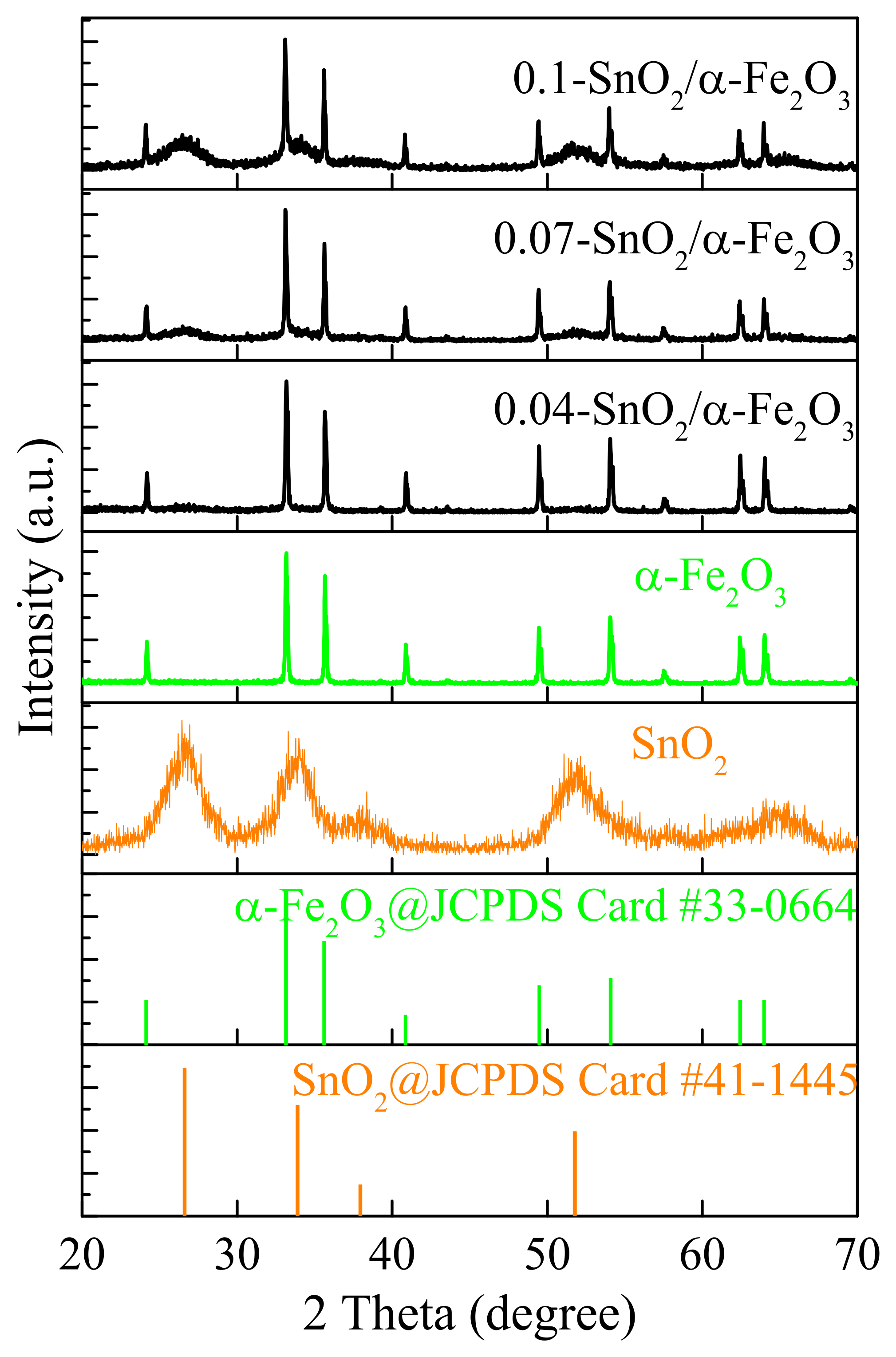
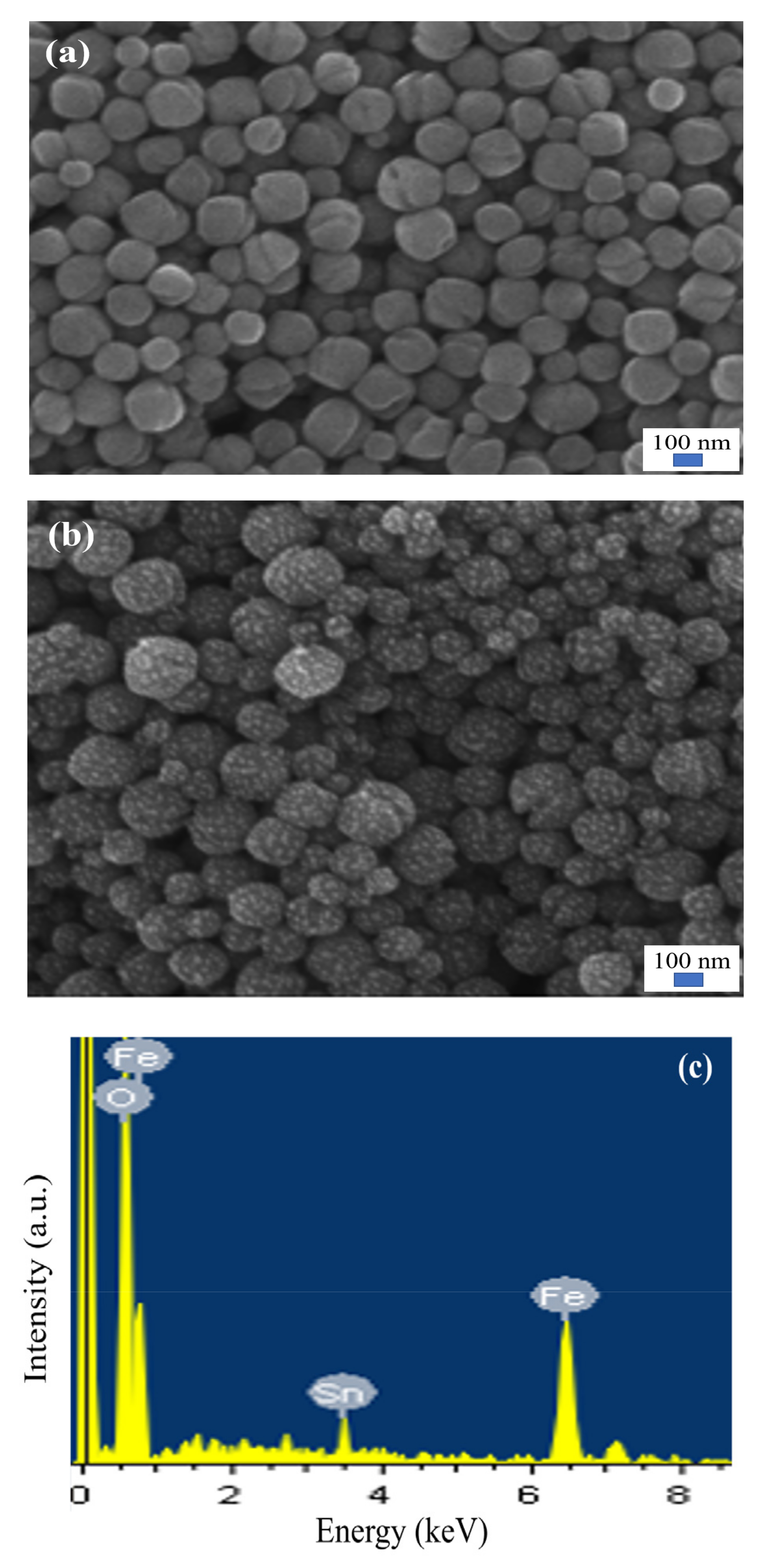
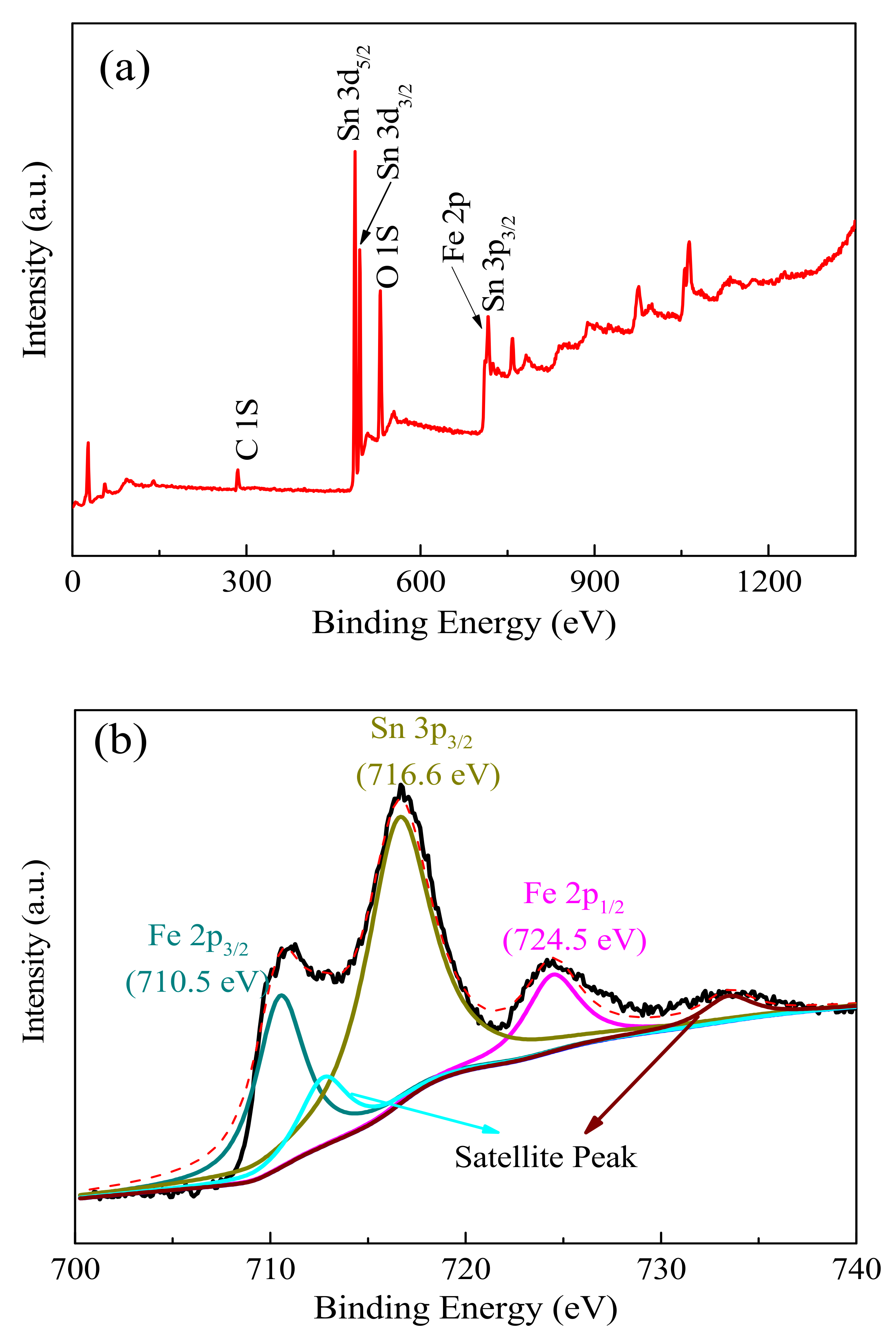
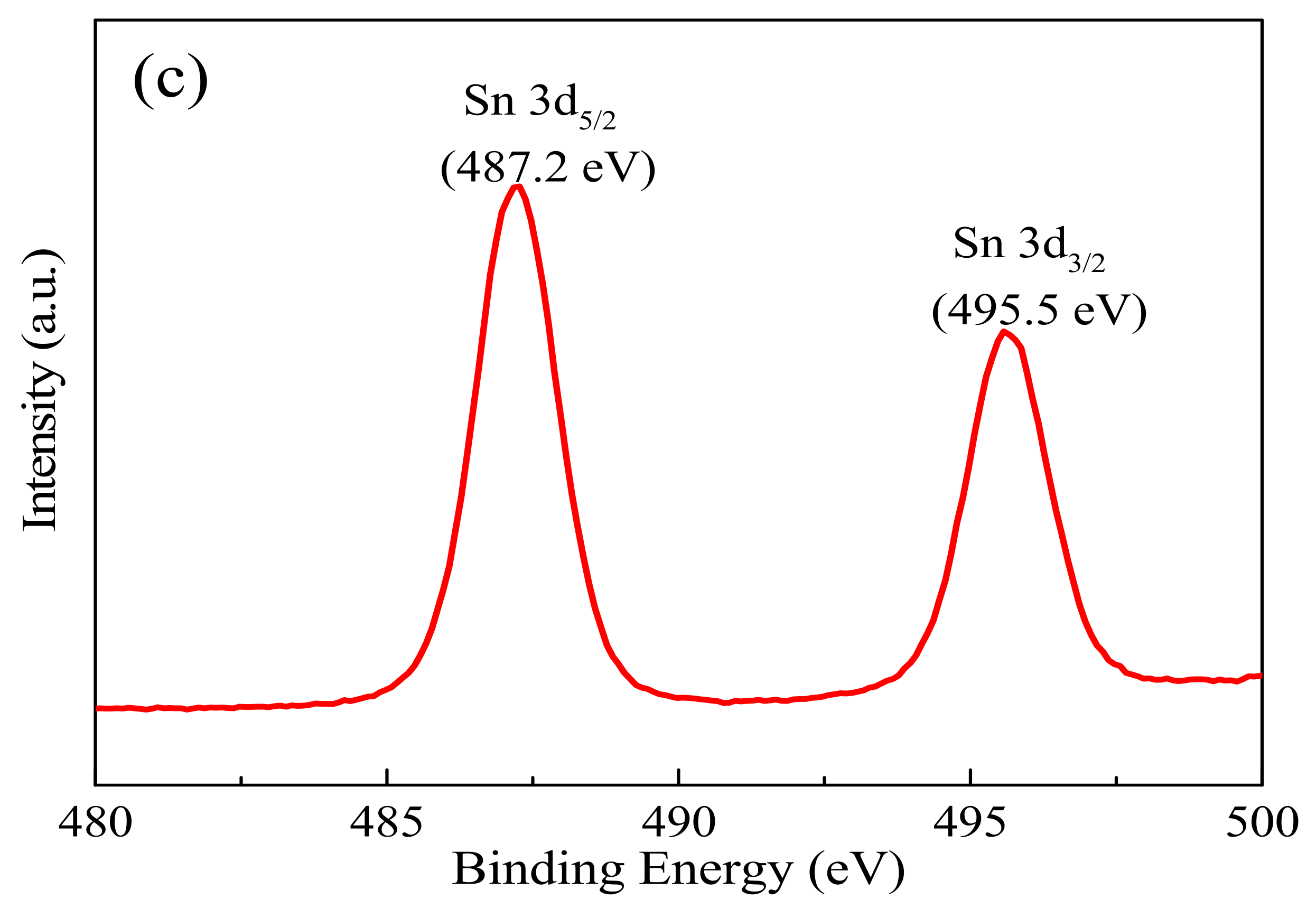
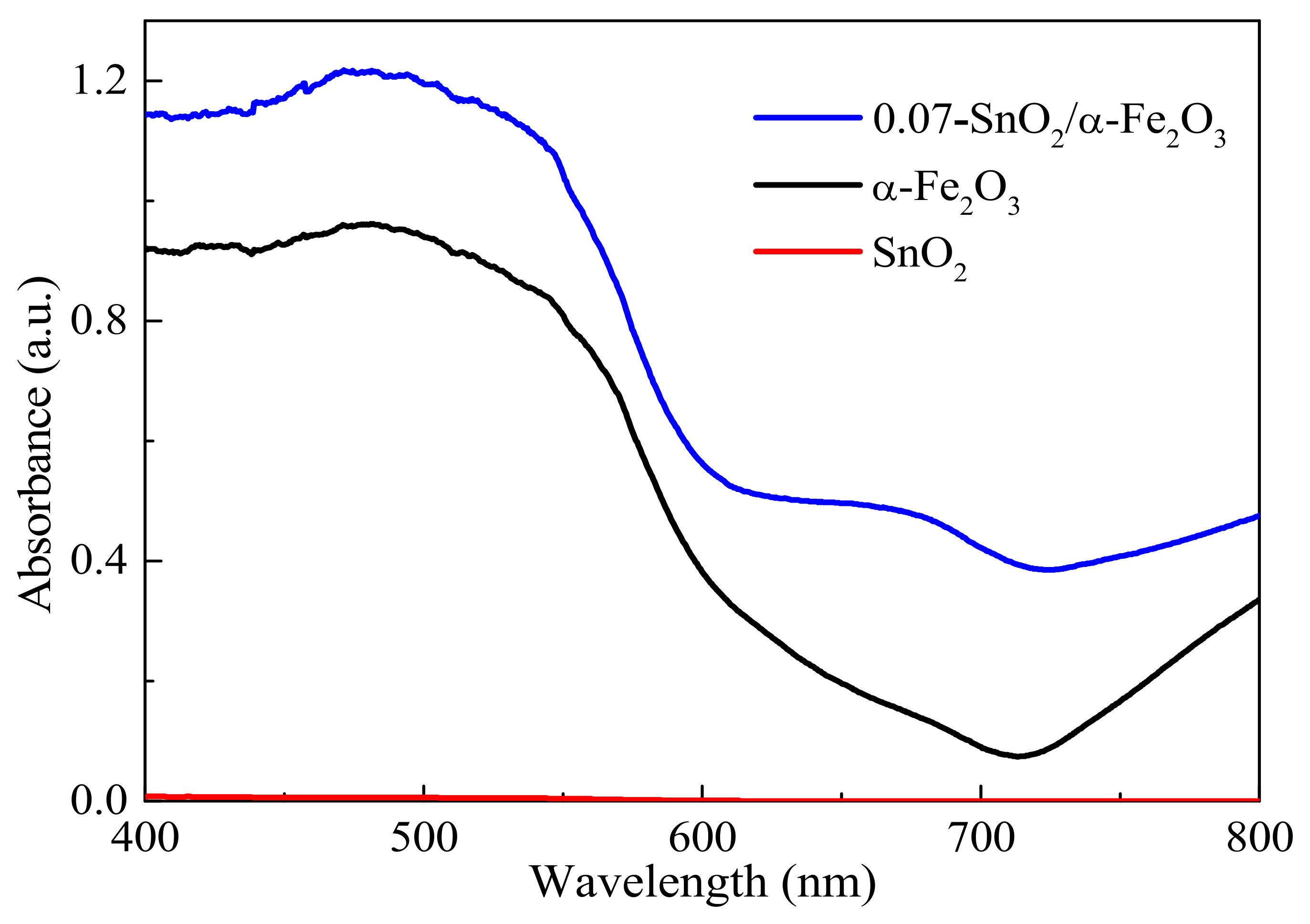
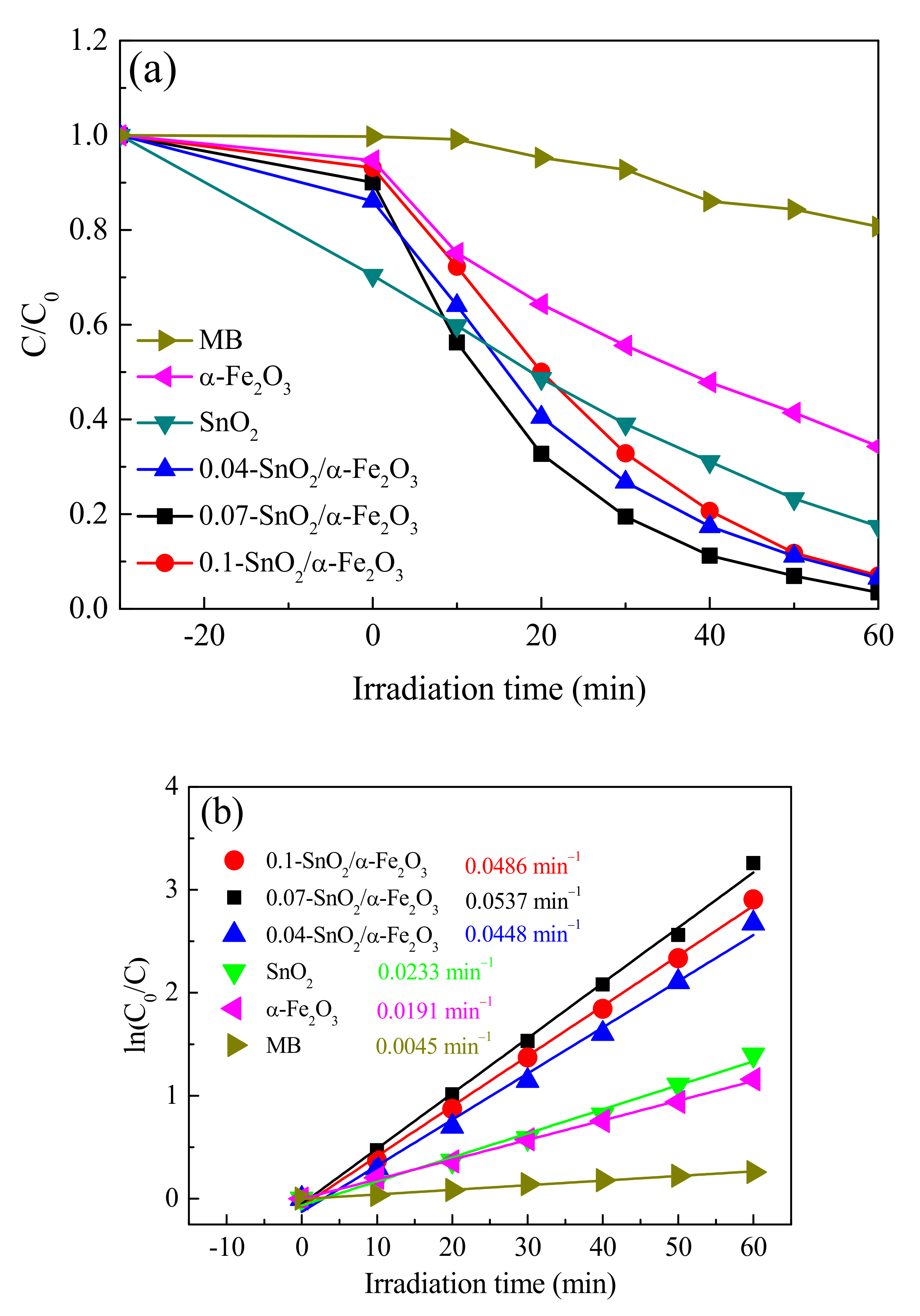

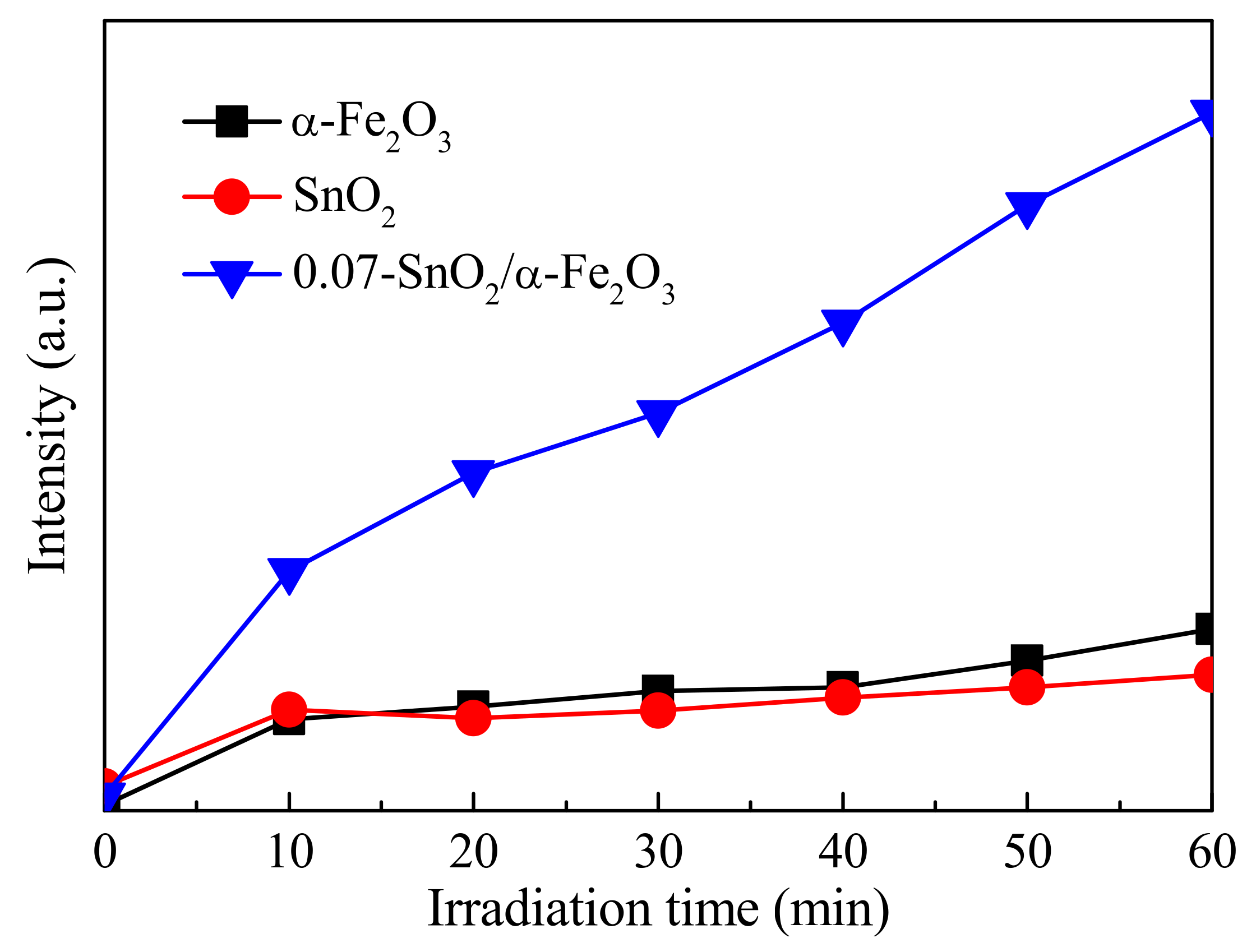
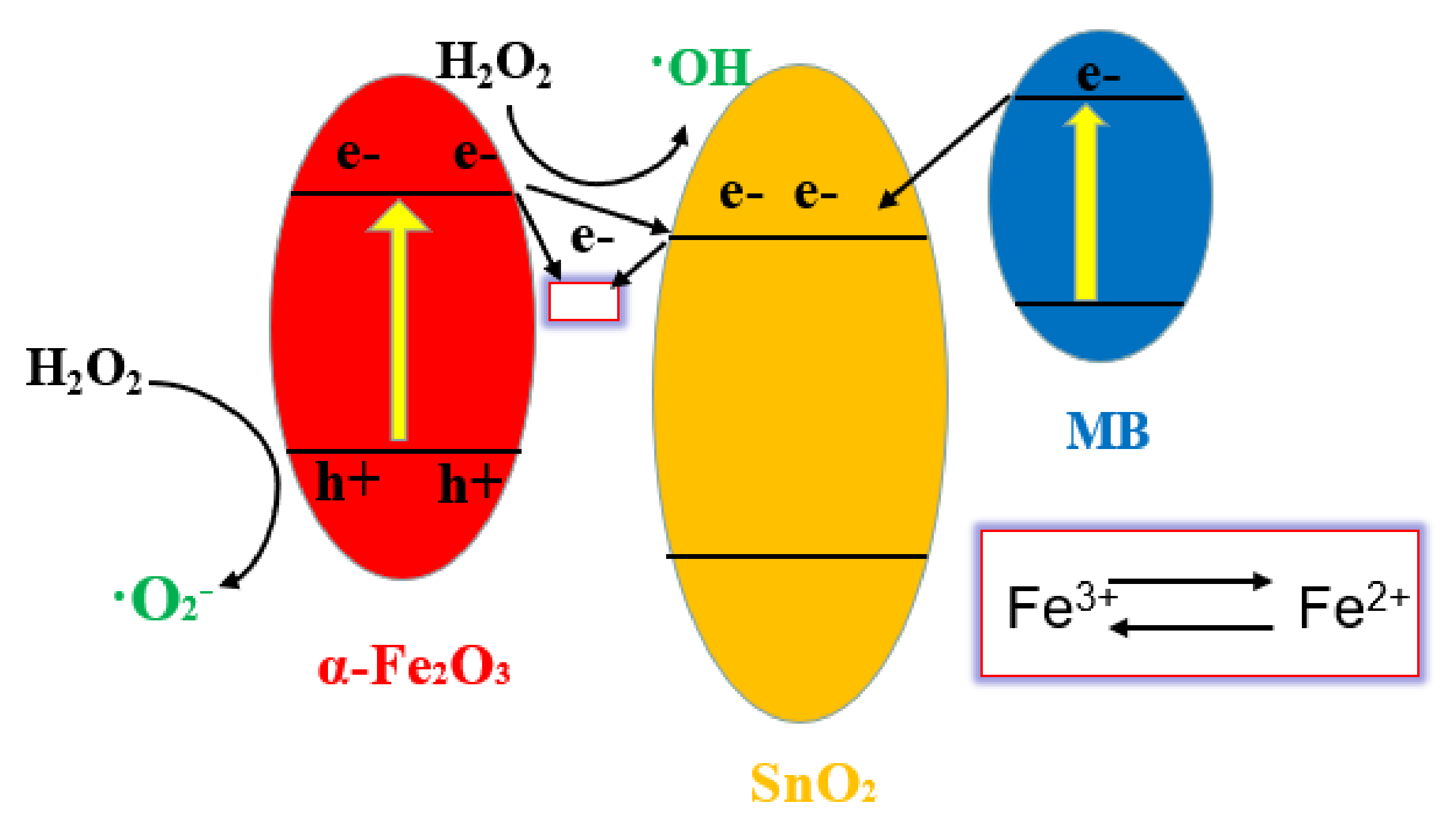
Publisher’s Note: MDPI stays neutral with regard to jurisdictional claims in published maps and institutional affiliations. |
© 2022 by the authors. Licensee MDPI, Basel, Switzerland. This article is an open access article distributed under the terms and conditions of the Creative Commons Attribution (CC BY) license (https://creativecommons.org/licenses/by/4.0/).
Share and Cite
Li, P.; Zhuang, X.; Xu, J.; Ruan, L.; Jiang, Y.; Lin, J.; Zhang, X. Enhanced Photo-Fenton Activity of SnO2/α-Fe2O3 Composites Prepared by a Two-Step Solvothermal Method. Materials 2022, 15, 1743. https://doi.org/10.3390/ma15051743
Li P, Zhuang X, Xu J, Ruan L, Jiang Y, Lin J, Zhang X. Enhanced Photo-Fenton Activity of SnO2/α-Fe2O3 Composites Prepared by a Two-Step Solvothermal Method. Materials. 2022; 15(5):1743. https://doi.org/10.3390/ma15051743
Chicago/Turabian StyleLi, Pinghua, Xuye Zhuang, Jiahuan Xu, Liuxia Ruan, Yangfan Jiang, Jiaxin Lin, and Xianmin Zhang. 2022. "Enhanced Photo-Fenton Activity of SnO2/α-Fe2O3 Composites Prepared by a Two-Step Solvothermal Method" Materials 15, no. 5: 1743. https://doi.org/10.3390/ma15051743
APA StyleLi, P., Zhuang, X., Xu, J., Ruan, L., Jiang, Y., Lin, J., & Zhang, X. (2022). Enhanced Photo-Fenton Activity of SnO2/α-Fe2O3 Composites Prepared by a Two-Step Solvothermal Method. Materials, 15(5), 1743. https://doi.org/10.3390/ma15051743





